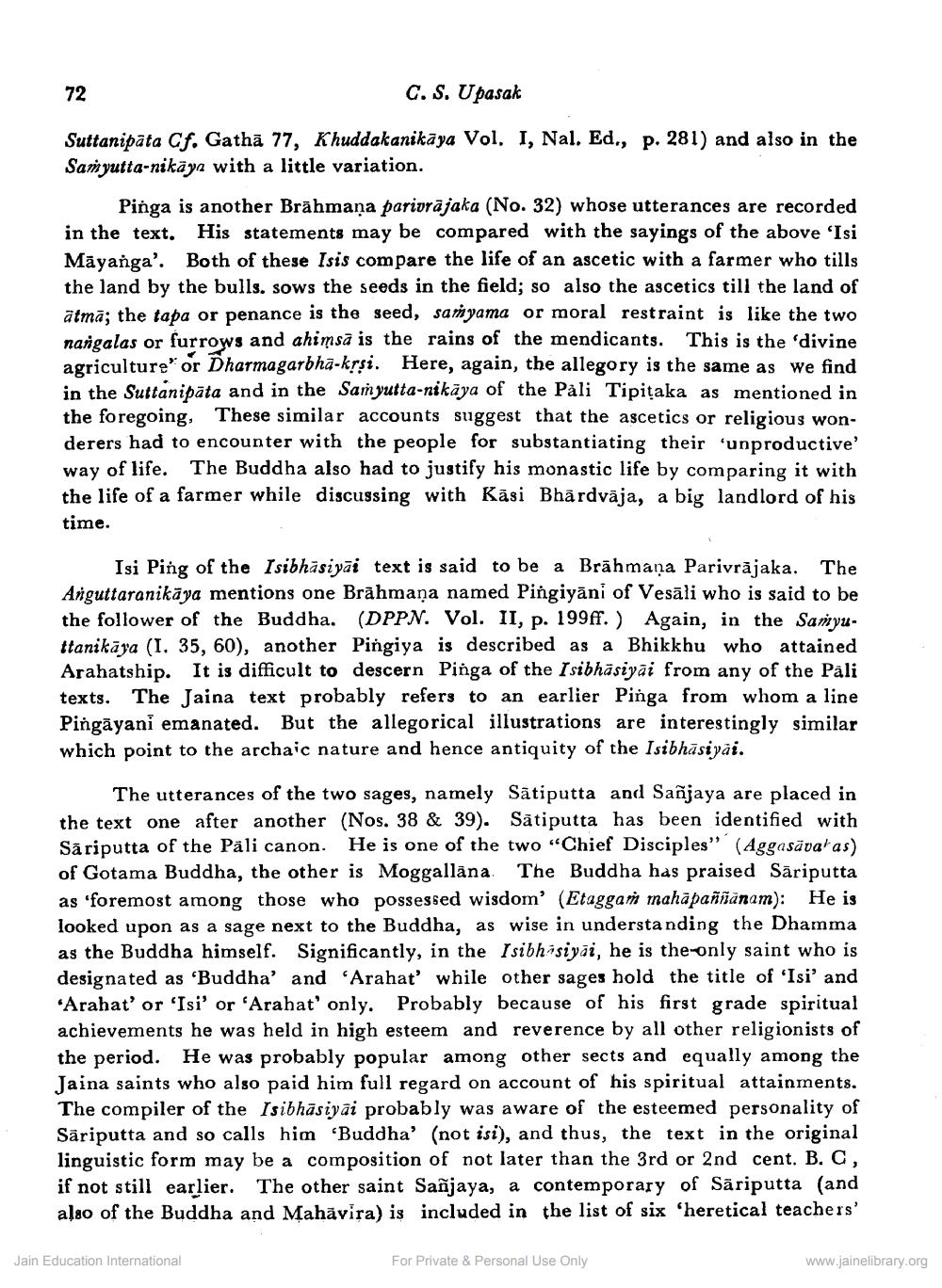Book Title: Isibhasiyai and Pali Buddhist Texts A Study Author(s): C S Upasak Publisher: Z_Aspect_of_Jainology_Part_3_Pundit_Dalsukh_Malvaniya_012017.pdf View full book textPage 5
________________ 72 C.S. Upasak Suttanipata Cf. Gathā 77, Khuddakanikāya Vol, I, Nal. Ed., p. 281) and also in the Samyutta-nikāya with a little variation. Pinga is another Brāhmaṇa parivrājaka (No. 32) whose utterances are recorded in the text. His statements may be compared with the sayings of the above 'Isi Māyanga'. Both of these Isis compare the life of an ascetic with a farmer who tills the land by the bulls. sows the seeds in the field; so also the ascetics till the land of ätmā; the tapa or penance is the seed, samyama or moral restraint is like the two nangalas or furrows and ahimsa is the rains of the mendicants. This is the divine agriculture" or Dharmagarbha-krsi. Here, again, the allegory is the same as we find in the Suttanipāta and in the Samyutta-nikaya of the Pali Tipitaka as mentioned in the foregoing, These similar accounts suggest that the ascetics or religious wonderers had to encounter with the people for substantiating their 'unproductive' way of life. The Buddha also had to justify his monastic life by comparing it with the life of a farmer while discussing with Kāsi Bhārdvāja, a big landlord of his time. Isi Ping of the Isibhāsiyāi text is said to be a Brāhmaṇa Parivrăjaka. The Anguttaranikāya mentions one Brāhmana named Pingiyāni of Vesāli who is said to be the follower of the Buddha. (DPPN. Vol. II, p. 199ff.) Again, in the Samyuttanikāya (I. 35, 60), another Pingiya is described as a Bhikkhu who attained Arahatship. It is difficult to descern Pinga of the I sibhāsiyai from any of the Pali texts. The Jaina text probably refers to an earlier Pinga from whom a line Pingāyani emanated. But the allegorical illustrations are interestingly similar which point to the archaic nature and hence antiquity of the Isibhāsiyai. The utterances of the two sages, namely Sātiputta and Sanjaya are placed in the text one after another (Nos. 38 & 39). Sātiputta has been identified with Sāriputta of the Pali canon. He is one of the two “Chief Disciples" (Aggasävalas) of Gotama Buddha, the other is Moggallāna The Buddha has praised Sāriputta as 'foremost among those who possessed wisdom' (Etaggam mahāpaññanam): He is looked upon as a sage next to the Buddha, as wise in understanding the Dhamma as the Buddha himself. Significantly, in the Isibhisiyāi, he is the only saint who is designated as 'Buddha' and 'Arahat' while other sages hold the title of 'Isi' and *Arahat' or 'Isi' or 'Arahat' only. Probably because of his first grade spiritual achievements he was held in high esteem and reverence by all other religionists of the period. He was probably popular among other sects and equally among the Jaina saints who also paid him full regard on account of his spiritual attainments. The compiler of the Isibhāsiyai probably was aware of the esteemed personality of Sāriputta and so calls him 'Buddha' (not isi), and thus, the text in the original linguistic form may be a composition of not later than the 3rd or 2nd cent. B. C, if not still earlier. The other saint Sañjaya, a contemporary of Säriputta (and also of the Buddha and Mahavira) is included in the list of six 'heretical teachers' Jain Education International For Private & Personal Use Only www.jainelibrary.orgPage Navigation
1 ... 3 4 5 6
